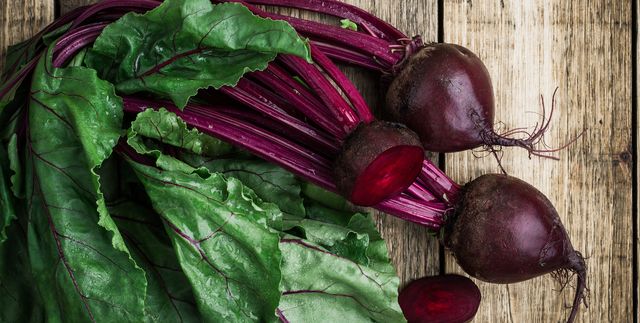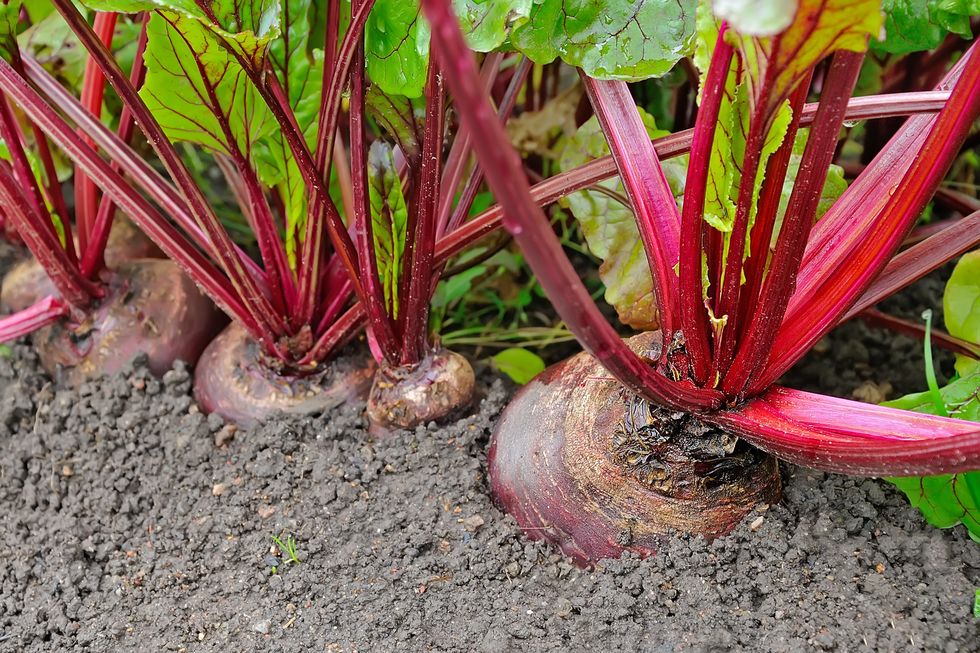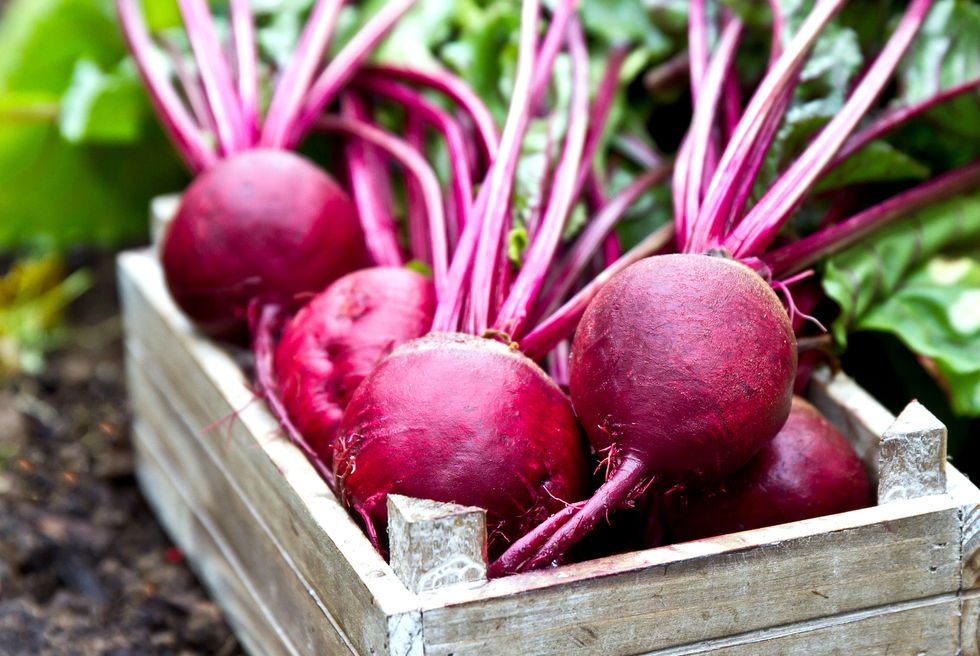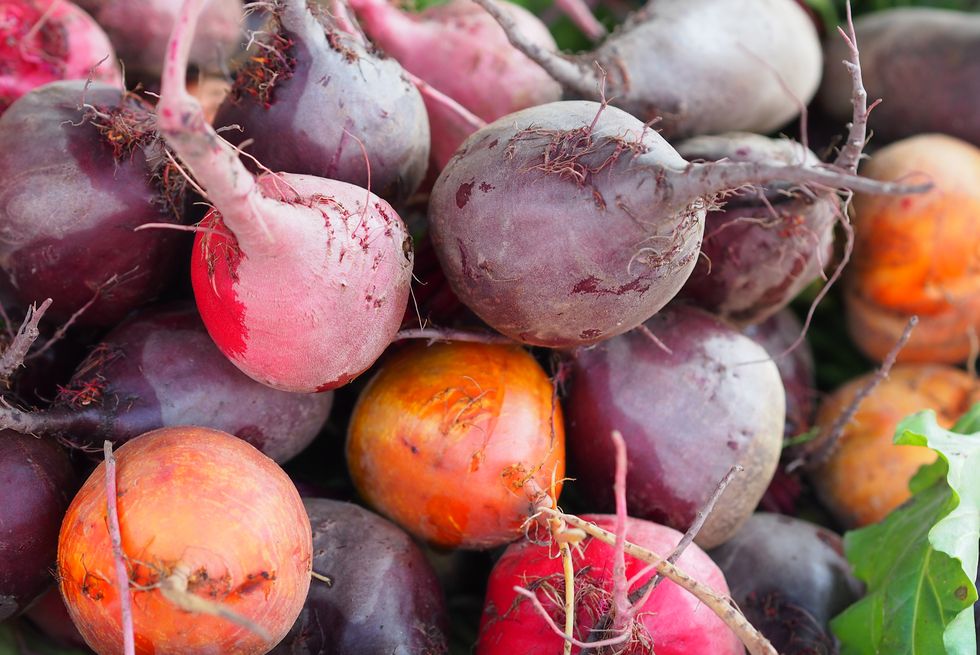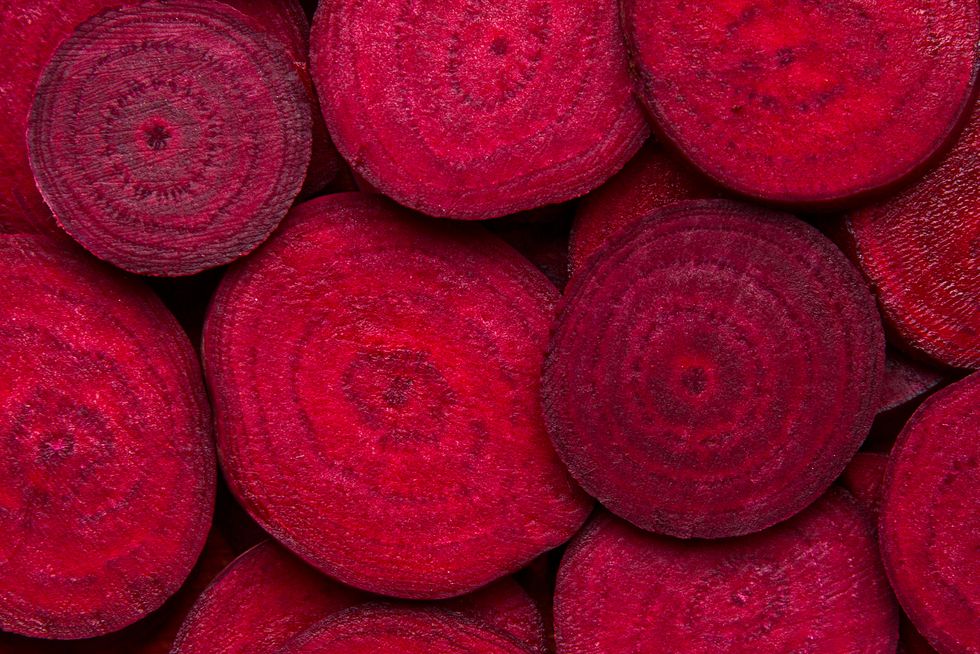High in fiber and rich in vitamins A and C, beets have more iron than other vegetables, including spinach.
Better yet, the classic beet's red coloring comes from betalains — a combination of the purple and yellow pigments that deter the formation of cancer-causing free radicals. "The betalain pigments are potent antioxidants," says Irwin Goldman, Ph.D., a beet geneticist at the University of Wisconsin at Madison.
Those pigments make beets a feast for the eyes as well as nourishment for your body. Beetroots' rich reds, golden yellows, creamy whites, and stunning stripes will add a brilliant splash of seasonal color to your autumn meals.
Their bright green foliage with red veins and stems will brighten up your garden beds, too. Beet greens are also tasty raw, braised, or stir-fried. And if you allow a little of the foliage to continue growing, you get plump roots that you can store and eat after cold weather sets in.
Growing Beets
Beets are adapted to grow in cool temperatures, making them a perfect vegetable to plant both in spring and late summer. They thrive when the days are warm (60 to 70 degrees) and nights cool (50 to 60 degrees). They may go to seed if temperatures drop below 50 degrees for an extended period. Sow the seeds in full sun for the best roots; if you don't have a sunny spot in your garden, plant them anyway — beets still produce a lot of leafy greens in partial shade.
Soil
Beets grow best in loamy, acid soils (pH levels ranging between 6.0 and 7.5). If your soil is heavy clay, rocky, hard, or alkaline, mix in an inch or so of compost. Add a bit of wood ash, if handy, because its rich supply of potassium enhances root growth.
If in the past you've harvested beets with black, hard spots in the flesh, they've suffered from the aptly named disease black heart, which is caused by a boron deficiency. Adding compost to the soil or spraying plants with seaweed extract will help somewhat, but if the symptoms persist, have your soil tested.
Planting
Beets aren't fond of crowds, so when sowing the seeds, plant them about 1 inch deep and 3 to 4 inches apart, or sow them closer together and use the thinnings later for salad fixings.
Spread a layer of grass clippings, shredded leaves, or straw around your beet patch to help keep the moisture consistent — that's essential for uniform root growth. Be sure to mulch well in spring to protect your beets from unexpected hot spells.
Containers
Get a pot that's at least 12 inches deep and you can grow beets on your deck, suggests Lance Frazon of John Scheepers Kitchen Garden Seeds in Bantam, Connecticut. "Beets are a natural for containers," he says, adding, "just make sure the containers are watered more than an in-the-ground garden."
Fall Harvest
You can plant beet seeds directly in your garden about eight to 10 weeks before the first expected frost and harvest them in time for the holidays. Beets harvested in fall have stronger colors than spring-planted beets, Goldman says, and fall beets often have higher sugar levels as well. So what are you waiting for? Plant a row or two this week.
Spring Harvest
For a spring crop, plant beets as soon as the soil dries out and you can work it, typically from March to mid-May. Where the weather remains cold and wet into spring, wait until April. Beets do transplant surprisingly easily for a root crop, so you can germinate the seeds inside and move them to the garden as soon as the soil dries out in spring.
Beet Growing Problems
Rotation Resistance
Beets are relatively disease- and pest-free, and even the problems they do have are relatively easy to manage. For instance, you can prevent diseases by rotating crops of beets, spinach, and Swiss chard with other types of vegetables. And use cover crops during the off-season, advises George Abawi, Ph.D., a plant pathologist at Cornell University.
Beet-Leaf Miners
Beet-leaf miners (Pegomya hyoscyami) can become a problem. Even if they do get into your beet leaves, you can just tear off the damaged portion, says Mary Ballon, owner of West Coast Seeds in Delta, British Columbia, She favors the "two fingers" method as the best way to control this pest, which tunnels into the leaves.
"Do a daily inspection of the leaves by feeling around the leaves for any bumps, and apply two fingers," Ballon says with a laugh. "It is the only pest that sits still to be squished!" To keep leaf miners and other pests away, simply place row covers over your beets during the insects' busiest time between May and late June.
Harvesting Beets and Beet Greens
You can start enjoying your beet crop at the first thinning. Simply cut greens during the thinning process to use in salads. Pull up baby beets when they reach 1 inch in diameter (and cook them up with their stems). When harvesting larger beets, leave 1 to 2 inches of the stems attached to prevent any staining or "bleeding."
For a fall harvest, pull up your beet crop after a hard frost. Be sure to cut off the tops close to the roots and store the beets in a box of sand in a cool place like a basement or a root cellar until you are ready to eat them. Greens can be cut, washed, and stored in the fridge until needed for salads, stir-fries, or steaming on the side as a "mess o' greens."
Best Beet Varieties
Heirloom Favorite: Detroit Dark Red, a classic dating to 1892, is still one of the best for sweet roots and tasty greens. Perfect fresh or for canning. Matures in 60 to 65 days.
Great for Storage: Red Ace produces tender greens perfect for salads and rich red roots that resist "zoning" (alternating red and white rings caused by excessive heat). Stores exceptionally well. Matures in 50 to 60 days.
Yellow Heirloom: Golden Beet has bright yellow flesh and a sweet potato-like flavor. Improve its low germination rate by soaking the seed in bathtub-warm water for one hour, then sow 1 inch apart. Sow extra-thick, since it doesn't produce as well as the red varieties. Matures in 50 to 60 days.
Heat- and Disease-Resistant: Kestrel, a sweet, dark-red globe baby beet, is very resistant to disease and bolting. Matures in 50 to 55 days.
Cold-Tolerant: Bull's Blood is an heirloom with gorgeous dark maroon-red leaves that provide a great splash of color for salads. It produces a tasty beet when harvested young (2 to 3 inches), and is extremely cold-hardy. Try this beet in your flower border — the wine-red leaves are highly ornamental and look great all summer. Matures in 35 to 40 days for greens; 55 to 60 days for roots.
Great for Greens: Lutz Green Leaf (sometimes sold as Winterkeeper) is an heirloom for fall harvest and winter storage. It grows large, with great-tasting green leaves. Its baseball-size, heart-shaped roots stay amazingly sweet and tender and store well through winter. Great for cooking. Matures in 70 days.
Variety Pack: Jewel-Toned is a blend of burgundy, golden, and candy-striped beets that's handy if you want to try them all.
4 Ways to Eat Beets
Steamed: While many gardeners still like to preserve beets through traditional pickling and canning, Steve Peters, commercial seed manager at Seeds of Change in Santa Fe, says he prefers the natural earthy taste of the root. "Steamed with a bit of butter is perfect."
Asian style: "I like to stir-fry them or steam them with a little honey glaze," says Radish Bruce, of Southern Exposure Seed Exchange in Virginia. "Sometimes we eat them raw, shredded up in delicious spring rolls."
Paired with fruit: For a tasty salad, "combine sliced cooked beets, chopped apples, and toasted walnuts with fresh greens," suggests Renee Shepherd, owner of Renee's Garden Seeds in California. "Or you can roast them with orange, ginger, and a touch of tarragon."
For dessert: If your family doesn't love beets, try them for dessert. Add freshly cooked, pureed beets to chocolate cake or brownie batter. This addition makes the cake extra-moist and a truly healthful treat.
